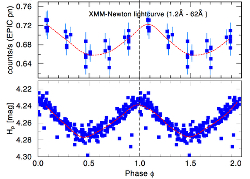 HEAPOW: Pulses from a Possible Pulsar Progenitor (2014 Jun 16)
HEAPOW: Pulses from a Possible Pulsar Progenitor (2014 Jun 16)
Stars more massive than about 8 times the mass of the Sun will eventually explode as supernova as they run out of nuclear fuel. They leave behind supernova remnants and, sometimes, tiny, rapidly spinning neutron stars called pulsars. Pulsars are highly magnetized, and radio and X-ray radiation near the magnetic poles produce pulses as the neutron star revolves. But X-ray pulsations have never been clearly observed in a massive star prior to the supernova explosion, until now. Astronomers, using the XMM-Newton X-ray Observatory, have for the first time seen X-ray pulsations in a massive star called Xi1 CMa. This star is a somewhat peculiar massive star, which shows evidence of an unusually strong magnetic field, and also evidence of optical pulsations caused by the expansion and contraction of the star every 5 hours. The XMM Newton X-ray data show that the star pulses in X-rays with the same period. The plot above shows the X-ray brightness variation (upper plot) compared to the optical brightness variation (lower plot) as measured by the Hipparcos astrometry satellite. The X-ray emission from massive stars like Xi1 CMa is believed to arise from hot pockets of shocked gas distributed to large distances in the thick stellar wind emitted from such stars, and/or pockets of hot gas trapped in the strong magnetic field, and it's not yet clear how the X-ray variations are coupled to the underlying changes in the size of the star.
ESA Science & Technology: Pulsating X-rays allow XMM-Newton to unmask a mysterious star
Discovery of X-ray pulsations from a massive star - Lidia M. Oskinova et al
- Nature Communications 5 4024 (03 Jun 2014) DOI: 10.1038/ncomms5024
| << Previous HEAPOW | High Energy Astrophysics Picture of the Week | Next HEAPOW >> |
